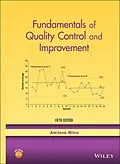The newest edition of an insightful and practical statistical approach to quality control and management
In the newly revised and thoroughly updated Fifth Edition of Fundamentals of Quality Control and Improvement, accomplished academic, consultant, and author Dr. Amitava Mitra delivers a comprehensive and quantitative approach to quality management techniques. The book demonstrates how to integrate statistical concepts with quality assurance methods, incorporating modern ideas, strategies, and philosophies of quality management.
You'll discover experimental design concepts and the use of the Taguchi method to incorporate customer needs, improve lead time, and reduce costs. The new edition also includes brand-new case studies at the end of several chapters, references to the statistical software Minitab 19, and chapter updates that add discussions of trending and exciting topics in quality control.
The book includes access to supplementary material for instructors consisting of a new instructor's solutions manual and PowerPoint slides, as well as access to data sets for all readers.
Readers will also benefit from the inclusion of:
* A thorough introduction to the evolution of quality and definitions of quality, quality control, quality assurance, quality circles, and quality improvement teams
* An exploration of customer needs and market share, as well as the benefits of quality control and the total quality system
* Practical discussions of quality and reliability, quality improvement, product and service costing, and quality costs
* A concise treatment of how to measure quality costs, the management of quality, and the interrelationship between quality and productivity
Perfect for upper-level undergraduate and graduate students in quality control and improvement, the Fifth Edition of Fundamentals of Quality Control and Improvement will also earn a place in the libraries of business students and those undertaking training programs in Six Sigma.
Autorentext
Amitava Mitra, PhD, is Professor in the Department of Systems and Technology and the former Associate Dean in the College of Business at Auburn University, Alabama. He has published over 70 journal articles and teaches quality assurance and improvement.
Inhalt
PREFACE xix
ABOUT THE COMPANION WEBSITE xxiii
PART I PHILOSOPHY AND FUNDAMENTALS 1
1 Introduction to Quality Control and the Total Quality System 3
1-1 Introduction and Chapter Objectives 3
1-2 Evolution of Quality Control 4
1-3 Quality 7
Quality Characteristics 8
Variables and Attributes 8
Defects 9
Standard or Specification 9
Quality of Design 10
Quality of Conformance 10
Quality of Performance 11
1-4 Quality Control 12
Off-Line Quality Control 12
Statistical Process Control 12
Acceptance Sampling Plans 13
1-5 Quality Assurance 13
1-6 Quality Circles and Quality Improvement Teams 14
1-7 Customer Needs and Market Share 15
Kano Model 15
1-8 Benefits of Quality Control and the Total Quality System 16
Total Quality System 17
1-9 Quality and Reliability 18
1-10 Quality Improvement 18
1-11 Product and Service Costing 19
Activity-Based Costing 20
1-12 Quality Costs 23
Prevention Costs 23
Appraisal Costs 23
Internal Failure Costs 24
External Failure Costs 24
Hidden Failure Costs 24
Quality Costs Data Requirements 24
Process Cost Approach 26
1-13 Measuring Quality Costs 27
Impact of Quality Improvement on Quality Costs 29
1-14 Management of Quality 31
1-15 Quality and Productivity 34
Effect on Cost 34
Effect on Market 34
1-16 Total Quality Environmental Management 37
Green Supply Chain 39
Summary 40
Key Terms 41
Exercises 41
References 46
2 Some Philosophies and Their Impact on Quality 47
2-1 Introduction and Chapter Objectives 47
2-2 Service Industries and Their Characteristics 47
Differences in the Manufacturing and Service Sectors 49
Service Quality Characteristics 50
Measuring Service Quality 52
Techniques for Evaluating Service Quality 52
2-3 Model for Service Quality 53
2-4 W. Edwards Deming's Philosophy 56
Extended Process 57
Deming's 14 Points for Management 58
Deming's Deadly Diseases 72
2-5 Philip B. Crosby's Philosophy 75
Four Absolutes of Quality Management 76
14-Step Plan for Quality Improvement 76
2-6 Joseph M. Juran's Philosophy 78
Quality Trilogy Process 79
Quality Planning 79
Quality Control 80
Quality Improvement 81
2-7 The Three Philosophies Compared 82
Definition of Quality 82
Management Commitment 82
Strategic Approach to a Quality System 83
Measurement of Quality 83
Never-Ending Process of Improvement 83
Education and Training 83
Eliminating the Causes of Problems 84
Goal Setting 84
Structural Plan 84
Summary 85
Key Terms 85
Exercises 86
References 88
3 Quality Management: Practices Tools and Standards 89
3-1 Introduction and Chapter Objectives 89
3-2 Management Practices 90
Total Quality Management 90
Vision and Quality Policy 92
Balanced Scorecard 94
Performance Standards 96
3-3 Quality Function Deployment 99
QFD Process 100
3-4 Benchmarking and Performance Evaluation 106
Benchmarking 107
Quality Auditing 110
Vendor Selection and Certification Programs 112
Vendor Rating and Selection 112
3-5 Health Care Analytics 115
Health Care Analytics and Big Data 116
Uniqueness of Health Care 116
Challenges in Health Care Quality 121
3-6 Tools for Conti...
